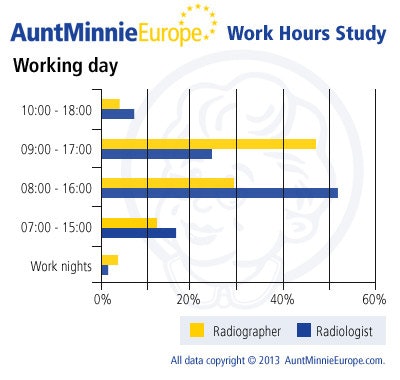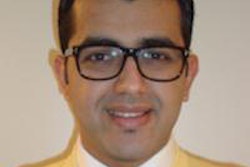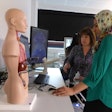
A third of radiologists typically work more than 50 hours a week, and almost 10% of them work more than 60 hours per week. The majority tend to start work at around 8 a.m. or earlier, and do an average of one on-call session per week.
These are among the key findings of AuntMinnieEurope.com's first working hours' survey. During May 2013, 410 medical imaging professionals completed the questionnaire, including 277 radiologists and 39 radiographers.

A lengthy working week remains the norm across much of Europe, the responses suggest.
"It's usually a case of early in, late away, and no lunch, with a relentless reporting load and multiple consultations daily," one radiographer based in the U.K. wrote. "Even if I manage to get a break, invariably it is interrupted by someone requiring advice or wanting to discuss an image. I predominantly report plain film as little is now reported by radiologist colleagues."
The work is cyclical, but during teaching semesters, 60-plus-hour weeks are typical, explained a radiology educator at a university in the Republic of Ireland who works most evenings between Monday and Friday.
An Italian radiologist who completed the survey has a maximum specified working week of 48 hours. "After an on-call shift, we must be on duty without recovery. The average wage is 3,000 euros per month, excluding taxes of 41%."
In Poland, wages are very low, and doctors tend to work in several different places, a radiologist from that country explained.
One U.K. radiologist must work approximately one on-call session per month, as well as providing cover at the hospital three times a month. On-call work is paid at a reduced rate of about 30%, depending on the frequency of sessions. The consultant (or senior) radiologist is the first person on call, not juniors. On-call frequency prior to 2012 was 1:8, but this was changed to comply with the European Working Time Directive.

According to a Swiss radiologist, "I seldom work less than 12 to 14 hours a day. An ordinary working day starts at 7:00 in the morning and ends after 19:00. Extra hours are not paid and not documented."
A radiographer from U.K. is in a similar position. "My contracted hours are 37.5 hours per week. In order to keep on top of the workload, we as a department work extra sessions in CT and MRI five evenings a week, plus Saturdays. Each session is three to six hours long. I never work less than six days per week."
Wide discrepancies
Some respondents said they found it difficult to answer our questions because of the varied nature of their work and the rapid pace of change in radiology.
"My typical working day could not be selected, but it is 7:45-17:30 hours. We have residents in training, so they are staying in the hospital during calls. We do have a lot of multidisciplinary meetings to take care of too," commented one radiologist based in the Netherlands. "It's a pity this survey is focusing so much on radiologists as employees; there should be a preselection (entrepreneurs versus employees) at the beginning of the survey."

A U.K. radiologist wrote that a typical working day ranges from nine to 10 hours, but this was not an option in the questionnaire.
"Due to the mix of clinical and academic work, a 'standard day' is 7 a.m. to 7 p.m., often including evenings and weekends," another radiologist in the U.K. stated. "Your survey sticks to eight-hour shifts only."
Another radiologist working in private practice in a Dutch hospital normally decides on the number of hours worked. There is an obligation to attend training courses for at least two weeks a year, but doctors must pay for the tuition themselves, according to the respondent.
Administrators and industry
Many radiology administrators are working long hours too, it seems. One administrator in Denmark typically starts work at 7:00 and finishes at 17:30, and occasionally has to do preparation work during weekends and evenings.
Conditions are not necessarily any better in industry. One U.K.-based application specialist who works in the field for an unnamed vendor reportedly has a minimum working week of 37 hours, but in reality an average week is almost 60 hours.
However, another application specialist based in Germany much prefers working in industry than clinical practice. "My current job situation is very good for work-life balance," the respondent said. "My previous job in the National Health Service in the U.K. was very poor, and I routinely worked more than 48 hours per week as well as several on-call sessions per week due to staff shortages. The only way to improve my situation and get some sleep and time away from work was to resign. It was a very sad situation."
Trends and work limits
Determining clear trends from the survey is no easy task, according to Jeff Miller, chief technology officer of AuntMinnie.com, who devised the charts for this article. For example, the survey asked about the maximum number of hours allowed per week, but looking at specific countries where respondents said their government set per week work hour limits, there were considerable differences. Some people indicated there was no limit and others said there were specific limits, Miller noted.
"From the survey, it looks like a lot of people don't get their overtime paid," noted Dr. Anagha Parkar, editorial adviser on AuntMinnieEurope.com and the person who came up with the idea of this survey during ECR 2013. "That means that the actual workload is much higher/underreported in these countries, and a lot of work is not actually registered."
She is concerned about an apparent lack of clear, common information about work limits. In her own country of Norway, the maximum hours per week allowed by the government is 60 hours for doctors, but only 48 hours for nurses, but the situation elsewhere seems less obvious.
"Workers don't really seem to know their rights. For me, that is the really interesting topic," commented Parkar, who is a radiologist at Haraldsplass Diakonale Sykehus in Bergen. "The EU has had this whole discussion on the working hours' directive, and there was huge outcry from some doctors about how it would ruin training, etc., and yet people don't appear to know their rights and limits."
Overall, the results of the survey probably show that working conditions in Scandinavia are particularly good, she suggested.
"We have flexible work hours at my institution, and it's very nice," a radiologist in Sweden said. "The total worked is 40 hour per week plus on-calls, but annual leave for me is 42 working days. On-calls are paid for and vary from 20% up to twice the normal rate, depending on the activity and time of day/weekday. You may add this to your salary and/or have days/weeks off."
Flexible working hours are great and effective, added a radiology administrator from Sweden, who also has the possibility to work extra at home on a full workstation, including postprocessing and StatDx.
Editor's note: We would like to thank everybody who completed this survey and who shared their experiences with us. To see the full survey, click here.
















